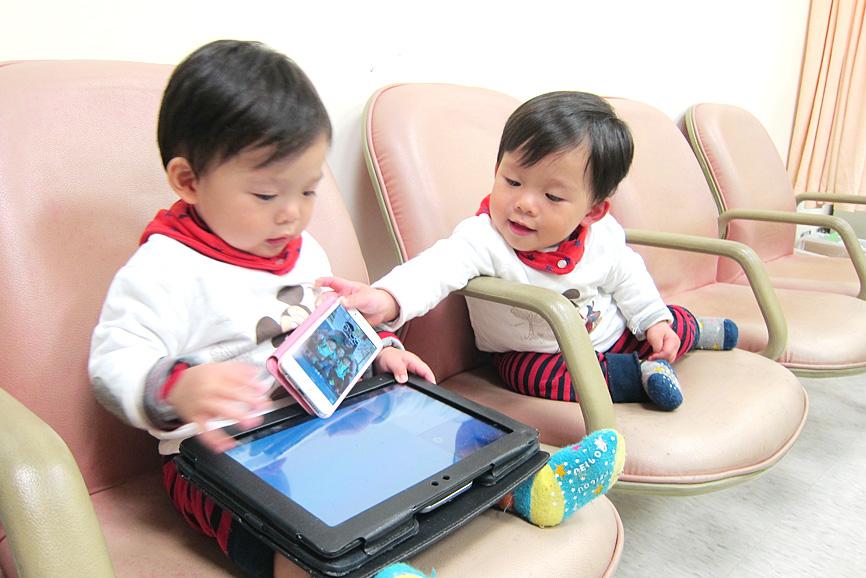More than 90 percent of Taiwanese aged three to five use personal electronic devices at home, with three-year-olds averaging a screen time of two hours and 17 minutes per day, a survey released yesterday said.
The survey of 1,732 parents, which counted the use of computers, communication devices and consumer electronics, was released at a news conference by National Taiwan Normal University (NTNU) and Parenting magazine.
It found that more than 90 percent of children of that age group used screen-based devices at home, with the youngest children surveyed having the longest average screen time.

Photo: Ho Tsung-han, Taipei Times
Three-year-olds averaged two hours and 17 minutes of screen time per day, while four-year-olds averaged one hour and 59 minutes and five-year-olds averaged one hour and 36 minutes, the survey showed.
Three-year-old children of lower-middle-class-background had the highest daily screen time, at three hours and two minutes on average, the survey showed.
“The more children are using these devices, the less they are interacting with their parents,” said Chang Chien-ju (張鑑如), a professor in NTNU’s Department of Human Development and Family Studies who is one of the survey’s directors.
“This negatively affects their social, emotional and physical development, as well as their cognitive and linguistic abilities,” she said.
Chang recommended that parents limit their children’s daily screen time to less than one hour, and to use the extra time to play, read or talk with their children, or have meals together.
K-12 Education Administration Director-General Peng Fu-yuan (彭富源) said that personal electronics use was highest among three-year-olds who had not yet entered preschool.
The Ministry of Education is considering sending information about how to reduce children’s use of electronic devices with the statements for monthly childcare subsidies that most parents receive, he said.
The Ministry of Health and Welfare recommends that three-year-olds be limited to 30 minutes of screen time per day and that four to six-year-olds be limited to one hour, with a 10-minute break every half an hour to rest their eyes.

The Executive Yuan yesterday announced that registration for a one-time universal NT$10,000 cash handout to help people in Taiwan survive US tariffs and inflation would start on Nov. 5, with payouts available as early as Nov. 12. Who is eligible for the handout? Registered Taiwanese nationals are eligible, including those born in Taiwan before April 30 next year with a birth certificate. Non-registered nationals with residence permits, foreign permanent residents and foreign spouses of Taiwanese citizens with residence permits also qualify for the handouts. For people who meet the eligibility requirements, but passed away between yesterday and April 30 next year, surviving family members

The German city of Hamburg on Oct. 14 named a bridge “Kaohsiung-Brucke” after the Taiwanese city of Kaohsiung. The footbridge, formerly known as F566, is to the east of the Speicherstadt, the world’s largest warehouse district, and connects the Dar-es-Salaam-Platz to the Brooktorpromenade near the Port of Hamburg on the Elbe River. Timo Fischer, a Free Democratic Party member of the Hamburg-Mitte District Assembly, in May last year proposed the name change with support from members of the Social Democratic Party and the Christian Democratic Union. Kaohsiung and Hamburg in 1999 inked a sister city agreement, but despite more than a quarter-century of

Taiwanese officials are courting podcasters and influencers aligned with US President Donald Trump as they grow more worried the US leader could undermine Taiwanese interests in talks with China, people familiar with the matter said. Trump has said Taiwan would likely be on the agenda when he is expected to meet Chinese President Xi Jinping (習近平) next week in a bid to resolve persistent trade tensions. China has asked the White House to officially declare it “opposes” Taiwanese independence, Bloomberg reported last month, a concession that would mark a major diplomatic win for Beijing. President William Lai (賴清德) and his top officials

‘ONE CHINA’: A statement that Berlin decides its own China policy did not seem to sit well with Beijing, which offered only one meeting with the German official German Minister for Foreign Affairs Johann Wadephul’s trip to China has been canceled, a spokesperson for his ministry said yesterday, amid rising tensions between the two nations, including over Taiwan. Wadephul had planned to address Chinese curbs on rare earths during his visit, but his comments about Berlin deciding on the “design” of its “one China” policy ahead of the trip appear to have rankled China. Asked about Wadephul’s comments, Chinese Ministry of Foreign Affairs spokesman Guo Jiakun (郭嘉昆) said the “one China principle” has “no room for any self-definition.” In the interview published on Thursday, Wadephul said he would urge China to